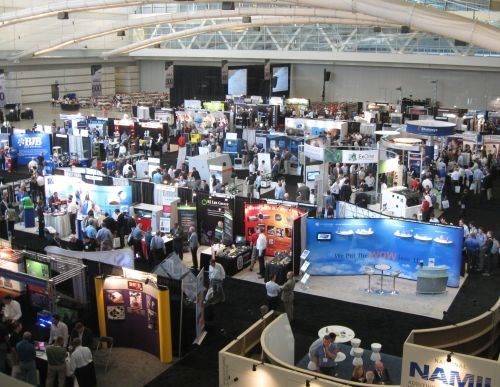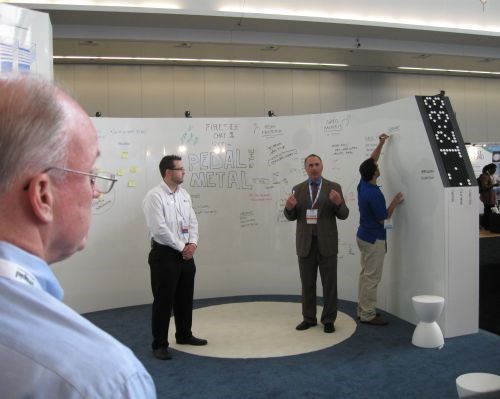Rapid Show Reveals Interest in Additive Manufacturing for Production
Interest in additive manufacturing was evident at last week’s Rapid show in Pittsburgh.

Interest in additive manufacturing was evident at last week’s Rapid show in Pittsburgh. Rapid is SME’s annual event focused on additive manufacturing technology and applications. At the show last week, the exhibit hall bustled and the conference sessions were frequently packed. Attendance nearly doubled that of last year, says SME. A veteran exhibitor told me he thought the opening day last week might have been the busiest day he’s ever experienced at a trade show.
However, it’s not just the quantity of attendees that distinguished this year’s show. The nature of those attendees was different as well. This year seemed to be the moment when Rapid transitioned from being focused on 3D printing as an aid to visualization and design, toward being focused on additive manufacturing more as a means of producing industrial parts.
Certainly that was the focus of a significant share of attendees, particularly those coming to the show for the first time. I thought I caught evidence of this when a keynote speaker asked for a show of hands from people who were attending the show for the first time. Perhaps 30 percent of the hands went up. But at a standing-room-only conference session focused on applying additive manufacturing to making end-use parts, the speaker asked the same question. This time, about 70 percent of the hands went up. The difference told me that, among the newest attendees to the show, the lion’s share of them were interested in additive manufacturing specifically for production applications.
A CNC shop owner I know gave me an example of this. He was at the show for the first time. When I ran into him, he pulled a machined part out of his pocket to show me why he had come. The complex part was difficult to machine, and he was here to explore whether additive manufacturing would enable him to produce it more efficiently.
Other points worth noting:
● While the show was underway last week, two important developments related to additive manufacturing were announced. 3D Systems announced plans to acquire most of Phenix Systems, marking the parent company’s move into metal part production. Meanwhile, GE announced two “Open Innovation” contests awarding cash prizes to entrepreneurs for redesigning an industrial part and demonstrating advanced 3D printing technique.
● NAMII’s presence at the show was interesting. The organization aims to be an encourager of additive manufacturing and a connection point for companies advancing the technology, and it illustrated this role with a booth that was essentially a giant wrap-around whiteboard inviting Rapid visitors to engage by sharing their thoughts. Speakers giving talks inside this booth were accompanied by NAMII personnel spontaneously taking notes on the booth’s surface as they spoke. The effect was energetic and, to put it plainly, fun. The photo below illustrates this—here are Tim Pasterik of ExOne and Greg Morris of GE speaking in the NAMII booth. (Consider also what this photo says about the maturing of this technology and the likelihood of its staying power. Here are employees of two publicly held American companies committed to the technology, speaking as guests of a government organization founded on that same commitment.)

Related Content
DMG MORI: Build Plate “Pucks” Cut Postprocessing Time by 80%
For spinal implants and other small 3D printed parts made through laser powder bed fusion, separate clampable units resting within the build plate provide for easy transfer to a CNC lathe.
Read MoreVideo: 5" Diameter Navy Artillery Rounds Made Through Robot Directed Energy Deposition (DED) Instead of Forging
Big Metal Additive conceives additive manufacturing production factory making hundreds of Navy projectile housings per day.
Read MoreHow Machining Makes AM Successful for Innovative 3D Manufacturing
Connections between metal 3D printing and CNC machining serve the Indiana manufacturer in many ways. One connection is customer conversations that resemble a machining job shop. Here is a look at a small company that has advanced quickly to become a thriving additive manufacturing part producer.
Read MoreWhat Is Neighborhood 91?
With its first building completely occupied, the N91 campus is on its way to becoming an end-to-end ecosystem for production additive manufacturing. Updates from the Pittsburgh initiative.
Read MoreRead Next
Alquist 3D Looks Toward a Carbon-Sequestering Future with 3D Printed Infrastructure
The Colorado startup aims to reduce the carbon footprint of new buildings, homes and city infrastructure with robotic 3D printing and a specialized geopolymer material.
Read MoreProfilometry-Based Indentation Plastometry (PIP) as an Alternative to Standard Tensile Testing
UK-based Plastometrex offers a benchtop testing device utilizing PIP to quickly and easily analyze the yield strength, tensile strength and uniform elongation of samples and even printed parts. The solution is particularly useful for additive manufacturing.
Read MorePostprocessing Steps and Costs for Metal 3D Printing
When your metal part is done 3D printing, you just pull it out of the machine and start using it, right? Not exactly.
Read More





















